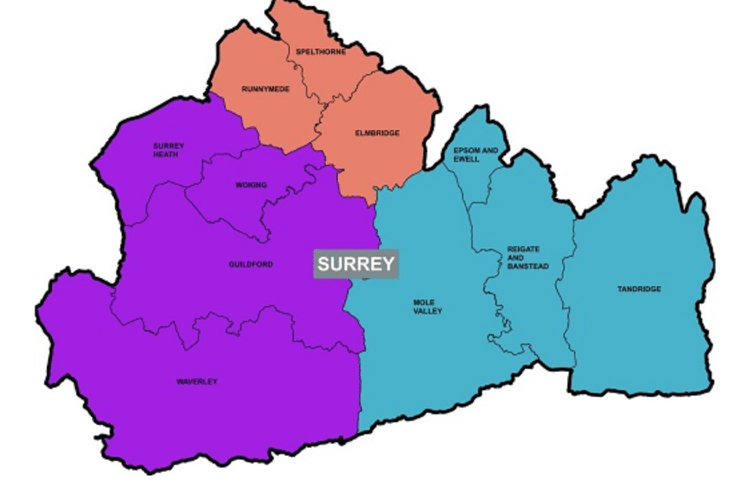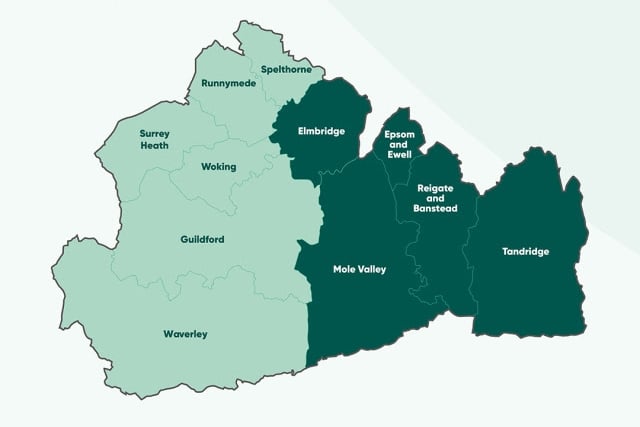Surrey County Council has set out how and why it wants merge with the 11 boroughs and districts to create two mega authorities as the deadline to submit local government reorganisation plans approaches.
The county council believes the best way forward is to split Surrey into eastern and western divisions.
On one side would be Woking, Spelthorne, Runnymede, Surrey Heath, Waverley and Guildford the other with Elmbridge, Mole Valley, Epsom & Ewell, Reigate & Banstead, and Tandridge.
The two new mega councils would have an overarching mayor responsible for, among other things, policing and fire services.
If the plans do go ahead, elections for the new shadow unitary councils would likely be held in May 2026, and a mayoral election most likely in 2027.
The county council argues its plan would “help ensure the future of local government in Surrey” was “cost effective, simplified and strengthened” while “unlocking further devolution for the county”.
It would, by their own figures, create the single largest combine authority ranked by gross domestic product per capita. Surrey County Council favours sticking to current boundaries because this would help unify public services, many of which are already shared.

It has rejected the idea of creating a single merged body despite it financially being the most beneficial.
Not only that, but forming a single mega council also comes with the “least amount of risk to vital social care services currently delivered countywide”, according to papers published ahead of the May 7 meeting.
The council has dismissed this because it would miss out on any devolved powers from central government given when two or more top tier authorities join forces. Instead, it is looking at what it calls the “two unitary model”.
Surrey County Council said this would be “the right size to achieve efficiencies, have better alignment between key areas of service expenditure and funding and therefore better able to withstand financial shocks, as well as better prioritise the delivery of high quality sustainable public services.”
Splitting into three, it suggests, “offers less financial resilience when needing to manage key areas of demand, in particular social care”.
Smaller authorities are less able to absorb the inherited debt, are likely to spend a greater proportion of revenue on debt servicing costs, and have less agility to redeploy resources in response to growing service demands, the council continued.
There would also be higher costs associated with the need to disaggregate services across three new authorities.
Beyond the financial risks, Surrey’s analysis of the three unitary model showed there would be greater disparity between the authorities across population, housing, flood risk , homelessness, and road maintenance backlogs.
Tim Oliver, leader of Surrey County Council said: “Our analysis shows that two unitary councils would bring the greatest benefit to Surrey’s residents.
“Two councils, in partnership with a mayor for Surrey, would save money, strengthen and simplify local government and with an east and west arrangement both councils would be in a strong position to continue to deliver high quality services to all Surrey residents.
“Of course, consideration must be given to the differing levels of debt that the authorities would potentially inherit, and we’re in talks with government about our request that the stranded debt be written off as well as providing financial support to those borough councils that need it.
“Most importantly, this proposal strengthens local community engagement.
“We know that residents want high quality services that are easy to access, and they want a real say in services and decisions that affect them. That’s why we’re proposing the creation of community-level boards across Surrey.
“These community boards will be locally determined but we would expect them to include representation from health partners, Surrey Police, voluntary groups, councillors, council staff, local town and parish councils and residents associations. We plan to pilot these boards over the coming months, and residents will have a say in how they are set up and delivered.
“We’re in a strong position as a county council, with good quality services and an excellent track record of stable finances after years of successful transformation. And working together with our residents and partners, we are well placed to deliver this important reorganisation.
“Ultimately, this work will unlock further devolution, meaning Surrey can elect a mayor which will bring more power, flexibility and funding closer to communities.”
Surrey County Council is expected to vote its plan through on May 7 before formally submitting it for consideration by the May 9 deadline



.jpeg?width=209&height=140&crop=209:145,smart&quality=75)
.jpeg?width=209&height=140&crop=209:145,smart&quality=75)
Comments
This article has no comments yet. Be the first to leave a comment.